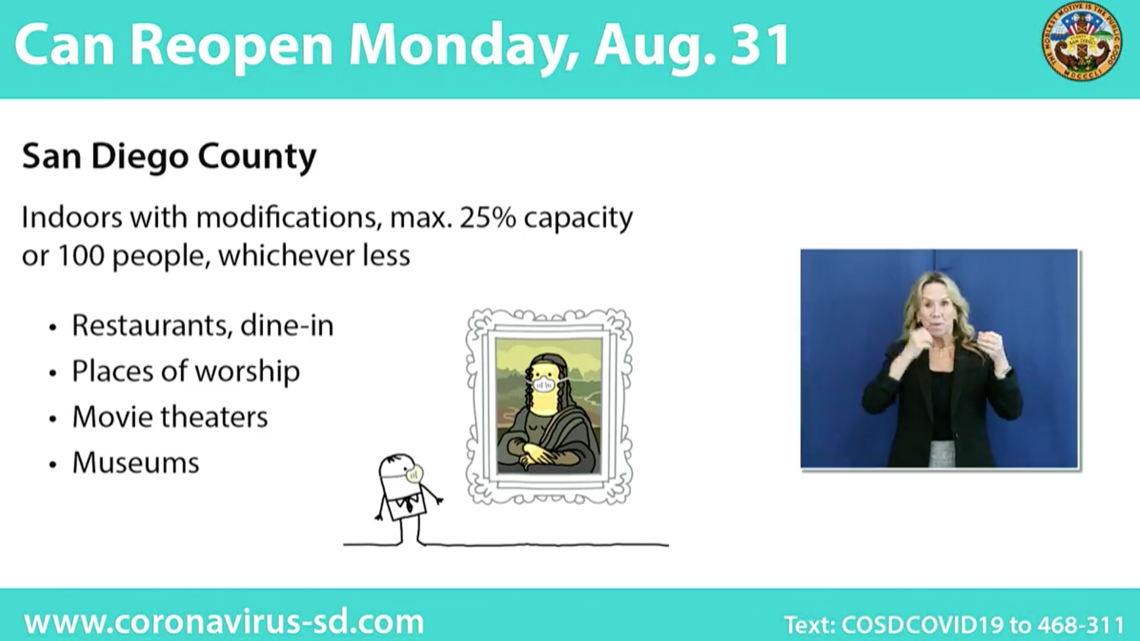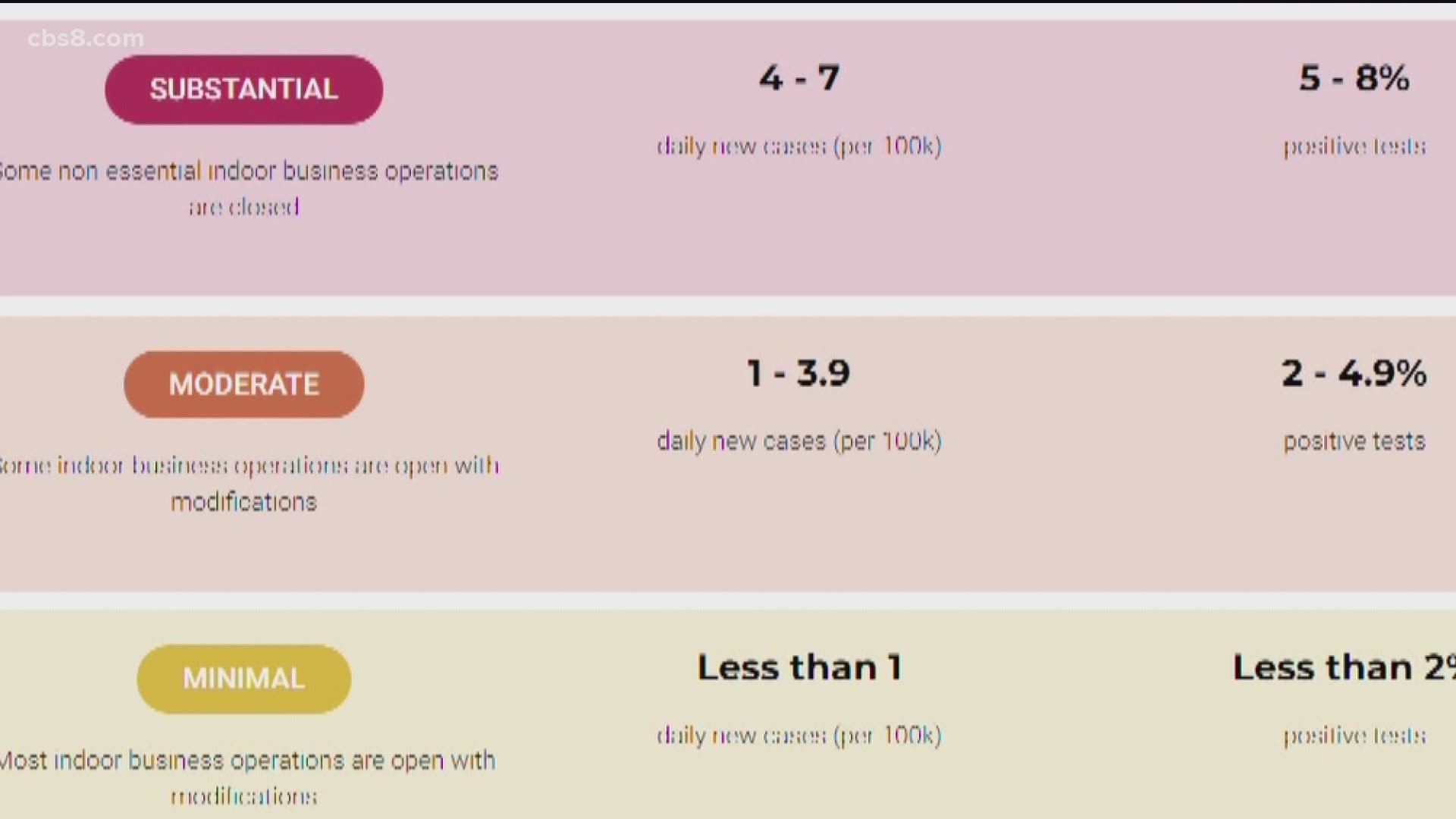SAN DIEGO — Hours after Gov. Gavin Newsom released a new system for the state that sorts counties into one of four tiers based on the extent of the area's COVID-19 outbreak on Friday, San Diego County officials announced some local businesses would be able to operate indoors in a limited capacity starting Monday.
On Aug. 31, restaurants, places of worship, movie theaters and museums will be allowed to maintain up to 25% occupancy or 100 people -- whichever is less. Gyms may operate with 10% occupancy. Hair salons, barbershops and nail salons may operate indoors with normal capacity. The impact to retail spaces currently open for indoor operations is unclear, although Dr. Wilma Wooten, the county's public health officer, alluded that they might be restricted to 50% occupancy.
All indoor businesses must still abide by social distancing- and face- covering mandates, as well as having a detailed safe reopening plan on file with the county.
Wooten said San Diego County had made it to "tier 2," the only county in Southern California to earn that designation. The county still has a "substantial" COVID-19 presence, but unlike Orange, Riverside, Los Angeles and Imperial counties it is not considered "widespread."
8,821 tests were reported to the County on Aug. 27 and the number of laboratory-confirmed cases was 3%.
The two metrics the state was monitoring in that tier list include an old one -- the percentage of positive tests -- and a new one -- the number of daily new cases per 100,000 people. San Diego County is at 3.8% and 5.8 per 100,000 respectively. To make it to the next tier, the county must show rates of between 2% and 4.9% positive tests and between 1 and 3.9 new daily cases per 100,000 population.
Because the county currently exceeds one of those numbers, it cannot start its path to the next tier.
According to Wooten, there is a 21-day mandatory wait time before any county can move between tiers, and a county must meet the metrics for the next tier for two straight weeks. Also, a county may only move one tier at a time.




These moves all appear to be in the interest of moving counties down the tier list toward full reopening. There does not appear to be any provision for a large, quickly spreading outbreak moving a county more rapidly back up the list.
The timeline for schools being able to open for in-person instruction on Sept. 1 is not affected by this new system of tiers, Wooten said. The state will monitor the data weekly, with results announced Tuesdays. To find out what is open in your county, click here.
Supervisor Nathan Fletcher voiced his concerns on the reopening plans on Friday:
"I believe we should take a more cautious and safe approach to re-opening than what was outlined today. My concerns are with the size, scope and speed of what is being reopened on Monday. While there are some lower risk entities that could safely reopen at this point, what we are doing is very similar to what we did in June with a large segment of indoor operations all opening at the same time. This led to a large increase in cases and required new restrictions.
At the same time we are moving forward on these reopenings we are trying to give schools a chance to start again and have college students returning to campus. I believe our focus now should be on a narrow section of low risk entities and doing everything we can to support our schools.
Additionally, we are struggling as a region in having successful enforcement and compliance and continue to see elected leaders, including the El Cajon Mayor, advocate against following public health orders. My fear is that the breadth and speed of what we are doing could cause a spike in cases that would trigger us moving back to a higher state tier and requiring additional closures. I would prefer a more cautious approach that gives us a higher probability of a smooth and steady recovery.
But even though I prefer a different path, the decision has been made and I will continue to work tirelessly to help us find a way to slow the spread, support our schools, and continue to help our community through this difficult time."
Meanwhile, County Supervisor Jim Desmond took an opposing stance.
"“The announcement by the Governor is not enough," Desmond wrote in a statement. "It's just more tinkering and choosing of winners and losers. While I'm pleased to see some industries be allowed to open, others continue to suffer greatly. State government continues to confuse people and paralyze the economy."
The county will be placed back on the state's monitoring list should it be flagged for exceeding any one of six metrics for three consecutive days. Those metrics are the case rate, percentage of positive tests, average number of tests a county is able to perform daily, changes in the number of hospitalized patients and percentage of ventilators and intensive care beds available.
285 new cases were reported in San Diego County on Aug. 27 for a total of 37,784. 3,065 or 8.1% of cases have required hospitalization. 746 or 2.0% of all cases and 24.3% of hospitalized cases had to be admitted to an intensive care unit.
Three new COVID-19 deaths were reported in San Diego County on Aug. 27. The region’s total is now 676. Three women died, all with underlying health conditions.

